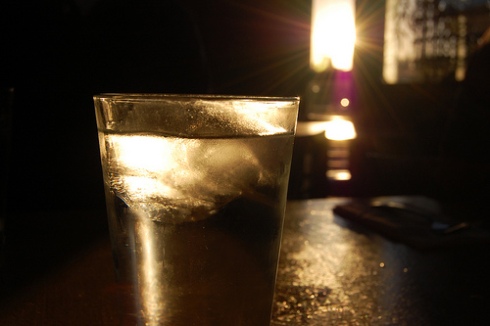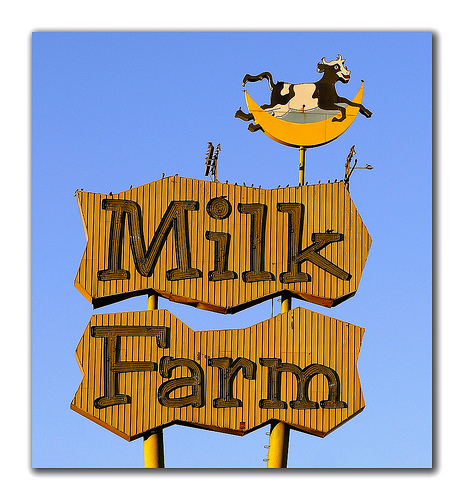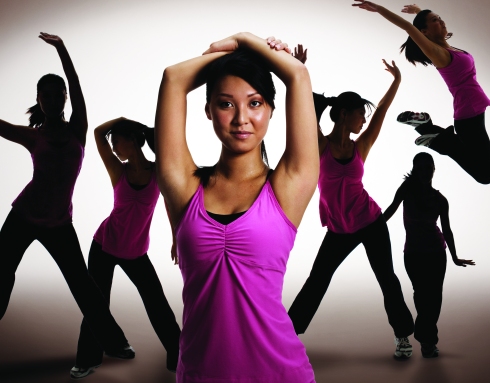You are currently browsing the monthly archive for August 2009.

Many people in the world have a condition on their skin that gives them the appearance of goosebumps all the time. It is called keratosis pilaris. Keratosis pilaris is a common skin condition that causes dry rough patches of acne-like bumps, usually on the thighs, buttocks or arms. It can also be on the face or back as well. The bumps are painless, and can be skin colored but at times will be red and inflamed. It is not a serious medical condition. It primarily leads to one being concerned about the appearance of their skin.
Keratosis pilaris is quite common in young children. It can occur at any age. It is common to develop by the age of 10 years old. It can worsen during puberty, but usually improves or goes away by the time the child becomes and adult. An estimated 40% of the adult population has this condition, while 50-80% of all adolescents do. It is more common to occur in females versus males.
Ultimately it is caused by a build up of keratin, a process called hyperkeratination. Keratin is a protein that protects the skin from harmful substances and infection. The build up of keratin blocks the opening of the hair follicle and creates the bumps we see. Often many blockages occur at once causing rough bumpy skin. Dry skin tends to worsen the condition. Because of this the condition may appear to improve during summer months but worsen during winter months when skin is extra dry.
It is unknown why the keratin builds up. Dermatologists believe it maybe genetic, and can be associated with other skin conditions such as atopic dermatitis or ichthvosis vulgaris. It often occurs in otherwise healthy people.
Keratosis pilaris does not have a cure. If often clears itself with time. You may wish to discuss your treatment options with your doctor. Some doctors will use Retin-A (vitmin A) to treat the condition because it aids in cellular turnover and will loosen the keratin. Corticosteroids are sometimes used to decrease inflammation. There are some preventative measures you can take to improve your skins condition.
- Be gentle when washing. Vigorous scrubbing will only irritate the skin and worsen the condition.
- After washing, gently pat your skin dry with a towel so that some moisture remains on the skin.
- Apply a moisturizer or lubricating cream while the skin is still moist from bathing, to lock in the moisture in the skin. One should use a moisturizer twice a day. Using a moisturize that contains urea, glycolic or lactic acids will soften the dry rough skin. The glycolic or lactic acid will also help remove the keratin from the skins surface because it will gently exfoliate the skin.
- While bathing use warm water, not hot water, and limit the length of time your shower is. Long, hot showers or baths remove oils from your skin, and lead to dry skin.
- Avoid harsh drying soaps. Choose a mild soap such as Neutrogena, Basis or glycerin soaps. Avoid deodorant or antibacterial detergents, which can be especially harsh. Ultimately you want your skin to feel soft and smooth after cleansing, never tight or dry.
- Gentle exfoliating treatments such as ‘Derm Renewal‘ at Healthworks can help as well.
Using a humidifier in your home will add moisture to the air in your home, and prevent the dry skin.
-Steph
Stephanie Keenan is a licensed esthetician. She is a graduate of Catherine Hinds with 900 hours of training in spa therapy, and a certification in aromatherapy.

(image: flikr, deborah jaffe)
It is funny how our perspective of age changes as we grow. I recently celebrated a birthday. When I sat down to write in my journal that morning, I spent a lot of time thinking about the fact that I am two years younger than my mother was, when she passed away.
As a child, I thought my mother was old and trying young things. She did aerobics and loved to swim. She was one of the most active mother s in the neighborhood.
Now, because I feel like I have so much to learn and I am still on my journey to find myself and what works best for me, I realized, my mother was very young.
I shared this with a colleague whose birthday is a few days before my birthday. She also reflected on this birthday and realized that she is at the age that her mother gave birth to her. She also realized how much her mother had done and that she is on her journey to learn how to better care for self and what a great responsibility it is to care for someone else.
I then asked one of the members of the circle who is a “vintage Citizen” as she refers to herself, to share her thoughts on age.
From her Bridge, she sees herself as a seeker of knowledge and as she discovers what is going on in the world, it energizes her.
Ms. Sylvia understands that knowledge brings responsibility, and this encourages her to maintain her health at peak performance. She is 75 years old.
The first time she attended the Circle, I was in awe of her presence, strength and beauty. I was holding onto everything she said.
Her most challenging enemy is the “energy stealer” from whom she flees like the wind. It is that moment where your mind is saying you can keep going and your body is telling you something else.
So I reflect on all the points in our journey and realize that we have chosen to move past what is expected of women our age. We are still active and on our journey to remain healthy both mentally and physically.
I am still making peace with the fact that I cannot keep the same level of intensity that I did as a competing athlete but on the morning of my birthday I went to a Bootcamp that Sarah was doing and walked away feeling like that 20 year old, track star, YES I DID!!!!
There are many factors that keep us feeling young at heart. Ms. Sylvia shared that humor is her constant standby, because it works!!! I think rest, good eating and a sound spiritual base develops an internal glow that shines outward.
I look around the gym and see women who keep moving and do not stop for that number to define them. I will continue to do so as my mother did and live each moment to the fullest.
-Yvette
Do you feel younger than your age? How do you do it? Leave your comments!
When it comes to health, no amount of expense is too much. But the fact is that we don’t have to spend too much money in order to stay healthy; all we need is a little bit of common sense and the right kind of lifestyle. When it comes to food, we must eat a balanced diet, one that includes the right amount of carbohydrates, proteins, fats and vitamins. There are some nutrients though that are more important than others and Vitamin D is one of them. Here are a few pertinent facts about this essential vitamin that all of us must be aware of:
- Vitamin D is essential for our body to absorb and use calcium more efficiently. Calcium is necessary for normal functioning of the nervous system, for bone growth, maintenance of bone density and muscle strength.
- Active Vitamin D (the active form of this vitamin present in our bodies and also known as calcitriol) boosts your immune system and prevents you from falling sick often.
- Vitamin D may improve insulin secretion and help diabetics
- This vitamin also helps patients who suffer from hypertension.
- Not many foods contain Vitamin D in their natural form.
- Foods like milk, orange juice and cereals are normally fortified with Vitamin D.
- Sunlight is a natural provider of Vitamin D; in fact, this vitamin is the only one that our body can create from sunshine.
- Most people get their entire life’s requirement of Vitamin D from exposure to sunlight
- Vitamin D increases levels of serotonin, the feel-good chemical, in the brain.
- Because of the scare of UV radiation and skin cancer, not many people dare to go out in the sun for long periods of time in order to get their daily dose of this essential vitamin.
- When we age, less Vitamin D is converted to its active form, which means we need more of it, especially if we’re not exposed to sunlight on a regular basis.
- Vitamin D requires bile in order to be absorbed by the intestine.
- When expectant mothers have low Vitamin D levels, there is a risk of the child being born with skeletal deformities and growth retardation.
- People who live in higher latitudes where there is less sunlight are prone to Vitamin D deficiency.
- Levels of Vitamin D higher than 2000 IU/day can be toxic.
- Vitamin D toxicity causes high blood calcium levels that are dangerous, poor muscle and nerve function, and kidney stones.
- Vitamin D toxicity does not result from exposure to sunlight.
- There are certain medical conditions that increase the risk of Vitamin D toxicity and some drugs that decrease your body’s level of Vitamin D absorption. So check with your doctor before you increase or decrease your intake of Vitamin D.
By-line:
This guest article was written by Adrienne Carlson, for Healthworks Fitness Centers, who regularly writes on the topic of online nurse practitioner schools . Adrienne welcomes your comments and questions at her email address: adrienne.carlson1@gmail.com
Do you know Fiona Fit?
She wants to see if you have what it takes!
Fiona is hosting a challenge at Healthworks for you and your friends! Time is running out to apply, have your applications in by the end of the day on Monday August 24th.
What does it take? Well, it doesn’t take this (click “this” for a funny example of what it doesn’t take). It does take you and 5-9 of your closest friends/enemies/coworkers/family members/cohorts (they do not have to be Healthworks members) who share your passion in living a healthy lifestyle. Selected teams will compete against the other teams in a four week Bootcamp style workout program at Healthworks for FREE! Best of all, the winning team will receive a shopping spree at CitySports worth $1500!
So why wait? Get your applications in soon, visit the official Fiona’s Challenge Website for more information or go directly to the application page to get started!
PS. There’s more! All teams that have applied are invited to an exclusive Fiona’s Challenge Launch Party at Eastern Standard on Tuesday September 1st from 6pm-8pm. All selected teams will be announced at the party.
R:\Marketing Team\Photos\Tank Designs\Heejin_Subway.jpg

(image: flikr, autan)
In her book, Cooking Green: Reducing Your Carbon Footprint in the Kitchen – The New Green Basics Way, Kate Heyhoe, editor of www.globalgourmet.com, suggests ways of reducing our carbon “cookprint”, defined as the entire chain of resources from acquiring food, preparing it and the waste produced in the process. Everyone that eats has a “cookprint” whether you cooked it or someone else did.
Her approach is practical: What can I do with what I have? No kitchens have to be redesigned, no appliances have to be replaced; it’s all about being more thoughtful and efficient. Take your refrigerator – the optimum overall safe temperature range is 37-40 degrees, for meats 31-36, dairy 33-38, fruits and veggies 35-40. Kate suggests storing meats in a lower drawer with chilled freezer packs. This way they are kept cooler without expending more energy. Extending the freshness life of your food means you shop less frequently – which is also an energy saver.
Kate recommends lots of fuel saving cooking tips. For example, when using the oven she forgoes pre-heating, just puts the food in, sets the temperature, and turns it off 15-20 minutes early. The residual heat will continue to cook the dish. She follows this same principle when cooking pasta. Bring the pot of salted water to a boil, put in the pasta, cover it, bring it back up to a boil and let it continue to cook for 2 minutes, turn off the heat and leave the pot covered for the appropriate cooking time with an active flame. The outcome is described to be perfect pasta.
Following her suggestions individually would make a difference; done collectively we could significantly decrease our carbon “cookprint” not just locally but globally. Be sure to check out the website.
Debbie Jones-Steele
Have you tried any of these suggestions? What do you do to keep your “cookprint” low? Leave your Comments!

(image: flikr, DAMRN)
LiveWellWomen.com has been up and running for about 8 months now. We would like to take a moment to look back and Highlight some of the most popular posts. As well as feature some posts that we really liked, but maybe our readers missed.
LiveWellWomen by numbers:
Nearly 40,000 Visits!
That’s over 160 per day since we have been up!
Our busiest day had over 1,200 visitors.
We have been named one of WordPress’ fastest growing new blogs!
There have been over 140 posts since we began.
Top 5 most visited posts:
5. Clear Flour Bakery– Learn about a great all-natural bakery in Brookline.
4. Healthy Snacking– Get some tips on Low-Cal yet filling and delicious snacks.
3. Dance your way to fitness with ZUMBA!– Learn more about the popular Latin Inspired Dance Class.
2. Sweet Potato Fries– A recipe for the healthy and delicious snack.
1. A Weekend in Miami– Live vicariously through blogger Laura’s weekend escape!
Some of our favorite posts:
Why Running is Actually Good for your knees– Get out there and run! But do it properly.
The Athlete’s Kitchen– Good training starts with good Nutrition.
Local v. Organic– Learn some critical differences between local produce and organic produce.
Sun Exposure and Vitamin D Deficiency– New studies show that Vitamin D is more important than ever.
Women and Strength Training– Learn why it’s important, and debunk some common misconceptions.
Enjoy!
As always, let us know what you think, and leave your comments.

Healthworks 24/7, a free meal planning program available to all Healthworks members, now has enhanced Meal Planner functionality. Choose from several options of meal plans, then receive guidance on a meal plan and portion sizes. New options include Fast and Convenient, Low Glycemic, Vegetarian, and Vegan. These are in addition to Heart Healthy, Low Dairy, and No Restrictions. Based on your current weight and goal weight profile, Healthworks 24/7 is able to calculate recommended calories and present meal plans within those recommended calories. Sign up for Healthworks 24/7 today!
Have you signed up for HW24/7 yet? Why wait? It’s Free!

(image: flikr, Logan Carter)
I’m on Week 5 of my half marathon training program, and today I finished my 5th long run and I completed 7.42 miles! I’m starting to find that sometimes my runs are just mind over matter. I know that my body is capable of continuing and pushing since I’m getting plenty of miles under my belt, but sometimes I let things get in my way – like how thirsty I am, for example.
This time all I could think about was an ice cold glass of water filled with ice for the last 3 miles of my run. Of course, I was probably really thirsty because it was hot out and I was running but I certainly wasn’t going to keel over if I didn’t get any. I just had to try and focus on something else before I really let that thought get the best of me. I decided to change my route so I could check out some different areas while still getting in my needed distance, and it worked, my pace picked up and I was able to forgot about my thirst. This doesn’t always work, but it’s worth a shot!
I like to use Go Run Easy to map out my long runs since I do like to change them almost every weekend. It’s good because I have an exact route in my head before I get outside that reaches my goal for the day, but I also am aware of good detours to take during the run to add in more distance or distract me from things on my mind. Does anyone have some good tips for a little mind over matter?
Laura M Cho
www.firstclasspanda.com
Help Laura out! How do you take your mind of the running on focus on the goal? Leave your comments!
Need some Help with your running routine? Join the Healthworks Run Club Tuesday Nights at Back Bay!

(image: flikr, happyshooter)
The Athlete’s Kitchen
Copyright: Nancy Clark MS RD CSSD, August 2009
“I’m 44. Should I start taking calcium pills?”
“A bone density test indicated I have the bones of a 70 year old—and I’m only 34. I guess I should have had more milk and less soda as a kid…?”
“Will drinking more milk help my stress fracture heal faster?”
Questions and confusion abound about the role of calcium in athletes’ diets. If you are like most active people, you may think, “Milk is for kids” and quench your thirst at lunch and dinner with (diet) soda or water. As a result, you can easily end up consuming a calcium-deficient diet (that is, unless you consume yogurt and cheese instead of milk).
Weight-conscious women, in particular, are known to have calcium-deficient diets out of (the unjustified) fear that milk’s calories will add to undesired weight gain (1). Many men also have calcium-poor diets. If they are not milk drinkers, means’ main sources of calcium are from the cheese on cheeseburgers and pizza. Not very health enhancing…
Given the average American lives for 77.7 years, maintaining bone health throughout the lifespan should be a priority for all athletes, starting as youngsters and continuing as master’s athletes. A calcium-rich diet, weight-bearing exercise (such as running, as opposed to biking and swimming) and strength-training to have strong muscles tugging on bones are all important factors for optimizing the bone density of both growing children and active adults.
Bones are alive and require a life-long calcium intake. If your family has a history of osteoporosis, your risk for “shrinking” (losing height) as you get older is high and you should pay special attention to maintaining your bone density. Female athletes with a history of amenorrhea also have a high risk for weak bones and should get their bone density tested so they know where they stand and if they need to take extra steps to try to enhance bone density. Here’s some information about calcium and bone health to help you enjoy lifelong health, no bones about it.
Q. Can I take a calcium supplement instead of drink milk?
A. While any calcium is better than none, taking a calcium pill does not compensate for a calcium-poor diet. A supplement offers calcium, but it does not offer the high-quality protein found in milk or soymilk, nor the myriad of other health-enhancing nutrients. Little babies thrive on milk, not calcium pills. Do you really think a pill can replace a whole food?
Q. I like to save calories by taking a calcium pill instead of drinking milk. Is that OK?
A. Not really. Although a calcium pill offers a low calorie alternative to consuming the recommended three (8-ounce) glasses of milk or yogurt each day, research indicates milk drinkers tend to be leaner than milk avoiders (1). I encourage my clients to embrace milk as a “liquid food” that is satiating and curbs one appetite. That is, milk can be more filling than the same number of calories from soda or juice.
Most of my active female clients reduce weight on 1,800 calories; men on 2,100+ calories. That breaks down to 500 to 600 calories per meal (breakfast, lunch, dinner) and 300 calories for a snack. Enjoying low-fat (soy) milk on cereal, a mid-morning latte and a yogurt for a snack seems a powerful way to spend 300 of those calories and approach the recommended intake of 1,000 milligrams of calcium per for adults 19-50 years; 1,200 mg for adults older than 50 years, and 1,300 mg for kids 9-18 years. If you are a parent, be a role model and drink milk at dinner to encourage a calcium-rich intake for your kids. Building strong bones during the ages of 10 to 18 is a wise investment for the future.
Q. I’m lactose intolerant. Can I get enough calcium from non-dairy foods like soymilk, spinach, broccoli and almonds?
A. For certain, you can get calcium from non-dairy sources. Soy milk is calcium-fortified and offers ~300 mg calcium in 8 ounces—similar to cows’ milk. Other convenient non-dairy calcium sources include fortified orange juice (350 mg/8 oz.) and fortified breakfast cereal, such as Total Cereal (1,000 mg/3/4 cup).
If you are do not consume dairy products or fortified soy products, you will have to work hard to consume adequate calcium. For example, to get the recommended intake from plant sources, you’d need to eat 10 cups of spinach salad, 3.5 cups of broccoli, and 4 ounces almonds (about 88 almonds @ 675 calories). That’s a lot of eating…
What you do NOT get from those plant sources of calcium is Vitamin D. Vitamin D enhances the absorption of calcium and is needed to not only protect bone health but also to reduce the risk of high blood pressure, diabetes, and heart disease; enhance immune function and reduce inflammation. Vitamin D is added to milk and some brands of yogurt, but is hard to find naturally in foods other than oily fish. Hence, non-milk drinkers have a high risk for not only calcium but also vitamin D deficiency.
Q. I live in Boston and spend lots of time outdoors in the sun. Should I take additional D even though I drink milk?
A. Yes, especially between Thanksgiving and Easter. Vitamin D deficiency is surprisingly common in people who live in northern latitudes (north of Atlanta GA), where the sun’s ultraviolet rays do not effectively convert the body’s inactive form of D (just under the skin) into an active form. And even Southerners need to be mindful. A study of southern distance runners indicates 40% of them were D-deficient (2). Indoor athletes (dancers, swimmers, hockey players, figure skaters, basketball players, gym rats, etc.) should ask their doctors about getting their blood tested to determine their level of vitamin D, and if it is low, take steps to correct the problem.
Q. Does the fat in milk contribute to heart disease?
A. Controversial. A study that tracked the health and dairy intake of 4,374 children for 56 years (between 1948 and 2006) reports there was no increased risk of heart disease or stroke among the 34% who died during that time—even though, as kids, the subjects in the study drank whole milk. In fact, the children who consumed the most milk and cheese lived longer. (3)
This study conflicts with the prevalent message to reduce the risk of heart disease by limiting the intake of milk’s saturated fat. Until more research clarifies this confusion, I recommend you enjoy low fat dairy/calcium-rich foods to help reduce excessive fat and calorie intake while maintaining a strong calcium intake.
Q. Will drinking extra milk help a broken bone heal faster?
A. Doubtful. Bones need time to heal … about 6 to 8 weeks. But perhaps you can reduce the risk of breaking a bone by building it stronger in the first place?
Do you get enough Calcium? What are some of your favorite Calcium Rich Foods?
Nancy Clark, MS, RD, CSSD (Board Certified Specialist in Sports Dietetics) counsels both casual and competitive athletes in her private practice at Healthworks, the premier fitness center in Chestnut Hill MA (617-383-6100). Her Sports Nutrition Guidebook, and food guides for new runners, marathoners, or cyclists are available via www.nancyclarkrd.com. See also sportsnutritionworkshop.com for information about upcoming workshops in Providence, Boston and Toronto.
References
1. Heaney R, Davies K, Barger-Lux M. Calcium and weight: clinical studies. J Amer College Nutrition 2002. 21(2):152S-155S.
2. Willis KS, Peterson NJ, Larson-Meyer DE. Should we be concerned about the vitamin D status of athletes? Int’l J Sports Nutr & Exerc Metab 2008 18:204-235.
3. van der Pols JC, Gunnell D, Williams G, Holly J, Bain C, Martin R. Childhood dairy and calcium intake and cardiovascular mortality in adulthood: 65-year follow-up of the Boyd Orr cohort. Heart. 2009; July 29. (Epub ahead of print)





